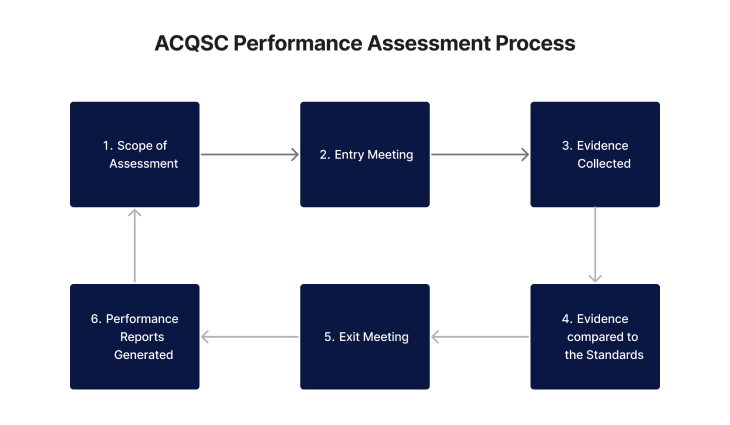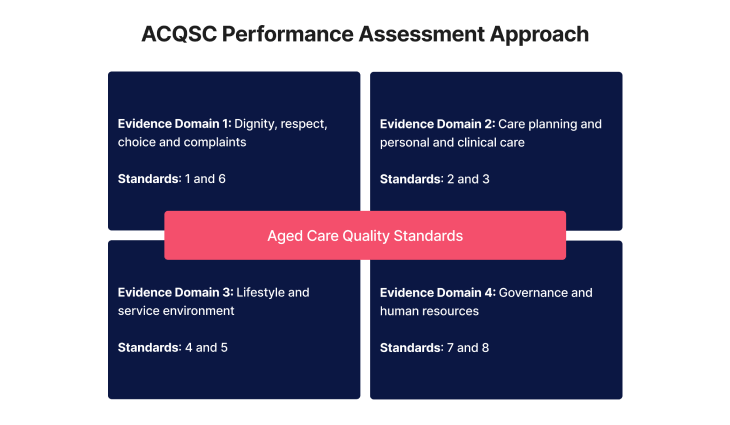This article is a simplified guide for managers, L&D practitioners, and educators in aged care about the compliance ratings used by the Aged Care Qaulity and Safety Commission. View the ACQSC assessment contacts in residential and home services information here.
Performance assessment contacts are just a single component of the types of assessments that the Aged Care Safety and Quality Commission perform to determine if an organisation is adequately maintaining compliance to the standards. You can learn more about assessment contacts in this guide here.
What are Performance Assessment Contacts as Part of the ACQSC?
Performance assessment contacts are pivotal in evaluating aged care providers against the mandated Quality Standards. These assessments are carried out by experienced regulatory officials who are registered quality assessors to determine whether an aged care provider is adequately meeting their compliance requirements.
What are Performance Assessment Teams?
Assessments are undertaken by skilled Assessment Teams, consisting of:
- Registered quality assessors
- Regulatory officials
How Are Performance Assessment Conducted? (Methodology)

The approach taken by quality assessors during assessments is outlined in Regulatory Bulletin Aged Care Quality Standards Performance Assessment Methodology (RB 2019-05).
What is the Scope of a Performance Assessment?
The scope of the performance assessment is an essential preliminary step taken by quality assessors. This involves:
- A thorough review of the provider's self-assessment documents and any previous assessment reports to understand past performance and areas of non-compliance.
- An examination of complaints made against the service and referrals from other regulatory bodies to identify potential risk areas.
- Engagement with information provided by consumers and providers, which contributes to the formulation of the assessment's focus.
During the scope phase, the assessment may target specific Quality Standards or compliance areas based on the provider's operational history and identified risks.
What is the Performance Assessment Approach?
Quality Standards are examined through four distinct evidence domains, guiding assessors in their methodology:

Each domain focuses on a different aspect of service delivery, from consumer dignity and choice to service environment, influencing how assessors conduct interviews, observations, and review documents. This ensures a holistic approach to assessing the quality of care provided.
It is important to note that the evidence domain approach is not currently applied to home services or services provided under the Aboriginal and Torres Strait Islander Flexible Aged Care Program.
What is an Entry Meeting?
An entry meeting is convened at the start of an on-site performance assessment to establish the groundwork for the assessment process. Key activities of this meeting include:
| Activity | Description |
|---|---|
| Introduction of Assessment Team | The assessment team presents their credentials, outlines their assessment methodology, and estimates the expected duration of the assessment process. |
| Structured Questions | The team asks targeted questions to the person in charge to help pinpoint areas of potential risk and gather initial impressions on compliance. |
| Document Request | Assessors request key documents, such as policies, procedures, and care plans, to begin their review of the service's compliance with the Quality Standards. |
What are the Initial Documents Requested During an Entry Meeting?
A detailed list of documents typically requested during the entry meeting can be found on the ACQSC's official information sheets and guidelines.
Who Communicates During the Performance Assessment?
Clear and open communication is maintained throughout the assessment to facilitate information sharing and to clarify details as needed. This includes discussions with staff, consumers, and their families to ensure a comprehensive understanding of the service's operation and care delivery.
What Evidence is Collected During a Performance Assessment?
Evidence is collected through a combination of interviews with staff and consumers, direct observations of care practices, and a detailed review of documentation. A purposeful sampling approach is employed to assess compliance with Quality Standards in an efficient and focused manner.
The assessment places a strong emphasis on the experiences and outcomes of consumers. This involves evaluating the tangible impacts of the service's application of Quality Standards on the care and services provided to individuals.
What Happens At the End of a Performance Assessment? (Exit Meeting)
At the conclusion of the on-site assessment, an exit meeting is held to summarize the findings and discuss the next steps. While this meeting does not pre-empt the outcomes of the assessment, it provides an opportunity for the service to ask questions and understand the assessor's observations.
What Happens After The Performance Assessment? (The Performance Report)
Following the on-site assessment, a comprehensive report is compiled, documenting the findings and assigning a compliance rating for each of the Aged Care Quality Standards. This report forms the basis of ongoing compliance and improvement efforts.
It's vital for providers to understand that the assessment report is not the final step. Post-assessment, providers are encouraged to implement continuous improvement plans to address any areas of non-compliance and to enhance their service delivery in accordance with the Quality Standards.
What's Included in the Performance Report?
- Compliance decision with each assessed requirement of the Quality Standards.
- Identification of improvement areas for compliance assurance.
- Inclusion of other relevant matters.
Regulatory Responses to Non-Compliance
Further actions may be required in cases of non-compliance The response taken usually corresponds to the level of severity (low, moderate, or high) and is decided on in a case-by-case basis.
For further information on how the Commission responds to non-compliance, view our guide here.
Need a system to support meeting compliance requirements in aged care?
Contact Ausmed today and see how we can support your aged care organisation today!
Related Resources
- How does the ACQSC identify, assess, and determine compliance?
- How Does the ACQSC Respond To and Manage Non-Compliance?
- The Aged Care Compliance Ratings Explained (ACQSC)
- What Are ACQSC Assessment Contacts (Guide for Managers)
Conclusion
In conclusion, performance assessment contacts serve as a critical component in the maintenance and enhancement of care quality within the aged care sector. By rigorous assessments and comprehensive reporting, they ensure providers adhere to the Quality Standards, thereby safeguarding the wellbeing of consumers. The Aged Care Quality and Safety Commission remains committed to transparency and excellence in regulatory processes to support the continuous improvement of aged care services throughout Australia.
References
- Aged Care Quality and Safety Commission, ‘RB 2020-09 Assessment contacts in residential and home services’, https://www.agedcarequality.gov.au
- Aged Care Quality and Safety Commission, ‘RB 2019-05 - Aged Care Quality Standards performance assessment methodology’, https://www.agedcarequality.gov.au



